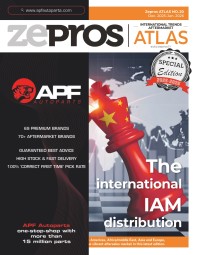
Stéphane Antiglio & Jeremy de Brabant, PHE: “Parts distribution is becoming more and more expensive"

Parts Holding Europe is forecasting a robust growth in 2023, driven by the general ageing of the european fleet. Beware however of inflation, whose many effects have yet to be fully felt… Crossed visions and analyzes of the chairman and the managing director of Part Holding Europe.
How did the 2023 financial year unfold for PHE?
Jeremy de Brabant: Overall, 2023 was a successful year, marked by a robust first half, with the group making strides across all its locations, achieving doubledigit organic growth surpassing the market average [Editor’s note: +12.2% in H1]. In terms of external growth, we welcomed AD Basconia into our family last February, expanding our footprint to the Spanish Basque Country. Our international development continues, contributing to a third of the group’s turnover, even though this aspect of our activity is relatively young, having started in 2016. Our strategy remains consistent: entering a market by aligning with reputable companies that share our vision and culture. The secondary goal is to secure a leadership position. Currently, PHE holds the top spot in France, Italy, and Spain, and the second position in Belgium. We anticipate closing the year with approximately €2.5 billion in turnover, surpassing our initial business plan.
Stéphane Antiglio: However, the year presented challenges, primarily due to increasing costs in the distribution business. The sector grappled with inflation in wages, energy, delivery vehicle expenses for purchase or rental, building rents, and a significant rise in the cost of holding stocks, with interest rates increasing by four points in a single year. This clearly marks a new context for the market!
What were the most dynamic areas?
J. de B.: Growth was generally consistent across Europe, except in Belgium, where inflation had a more pronounced impact on certain cost lines, especially salaries. However, our members outperformed the market in Belgium as well. On a broader scale, average annual mileage has not yet returned to pre-Covid-19 levels in Benelux, in contrast to southern European markets.
S. A.: Fleets are aging globally, a situation beneficial for IAM, and consequently for independent distributors and garages. Vehicle prices have surged in recent years, and consumer uncertainties around electric vehicles persist. All of this fosters a wait-and-see attitude, contributing to the aging of the european car fleet.
Are the challenges in the new car market leading major brand networks to enhance their aftersales activity?
S. A.: Indeed, manufacturer networks are expanding their presence in after-sales, offering special deals and promotions. They aim to enhance competitiveness during a period of challenging vehicle sales. However, structurally, they face disadvantages compared to multi-brand garages. This includes lower network coverage and flexibility. Multi-brand networks establish closer connections with consumers, exhibit greater agility, and, most importantly, are more cost-effective, a crucial advantage during a period when household purchasing power is under strain. These networks hold significant advantages in hand.
Is the transition to EVs already having an impact on business in the markets where you are present?
J. de B.: The electrification of the fleet is advancing more rapidly in Northern regions than in Southern parts of Europe. However, it is progressing less swiftly than initially projected for various reasons: vehicle prices, electricity costs, the availability of charging stations, and more. Following our motto ’Repair today, prepare tomorrow,’ we are getting ready for the influx of electric vehicles and plug-in hybrids in our workshops. Through the AD Institute, the Move Up 2027 programme initiated by Doyen, and the Millennium program in Spain, we are equipping our members for the rise in electric cars. This surge represents an evolution, not a revolution.
Are disruptions in supply chain resolved now?
J. de B.: While the situation has improved, we are still far from the service rates observed before Covid-19. Very few suppliers have returned to their pre-pandemic service levels. Distributors must maintain high inventory levels to meet the needs of garage customers, and that is the approach PHE has chosen. The challenge of inventory financing is significant because compensating for shortages through overstocking incurs additional costs. We understand that the supply chain issue is challenging for OEMs. PHE and its suppliers are collaborating to find solutions and enhance the situation.
How do you view 2024?
J. de B.: We can anticipate a potential stabilisation in the rise of parts prices. However, in terms of costs, inflation will persist, encompassing increases in salaries, rents, insurance costs, and financing of stocks, posing the risk of a ’pincer effect’ in the upcoming financial year. Careful management of our businesses will be essential.
S. A.: Similar factors will lead to similar effects for our garage customers. They will need to raise employee salaries due to the inflation observed in 2023 and navigate increased costs in energy, insurance, and more. Simultaneously, they must continue investing in team training and funding new equipment for their workshops. It’s likely they will need to adjust their labour rates, which doesn’t favour a reduction in maintenance and repair costs.










